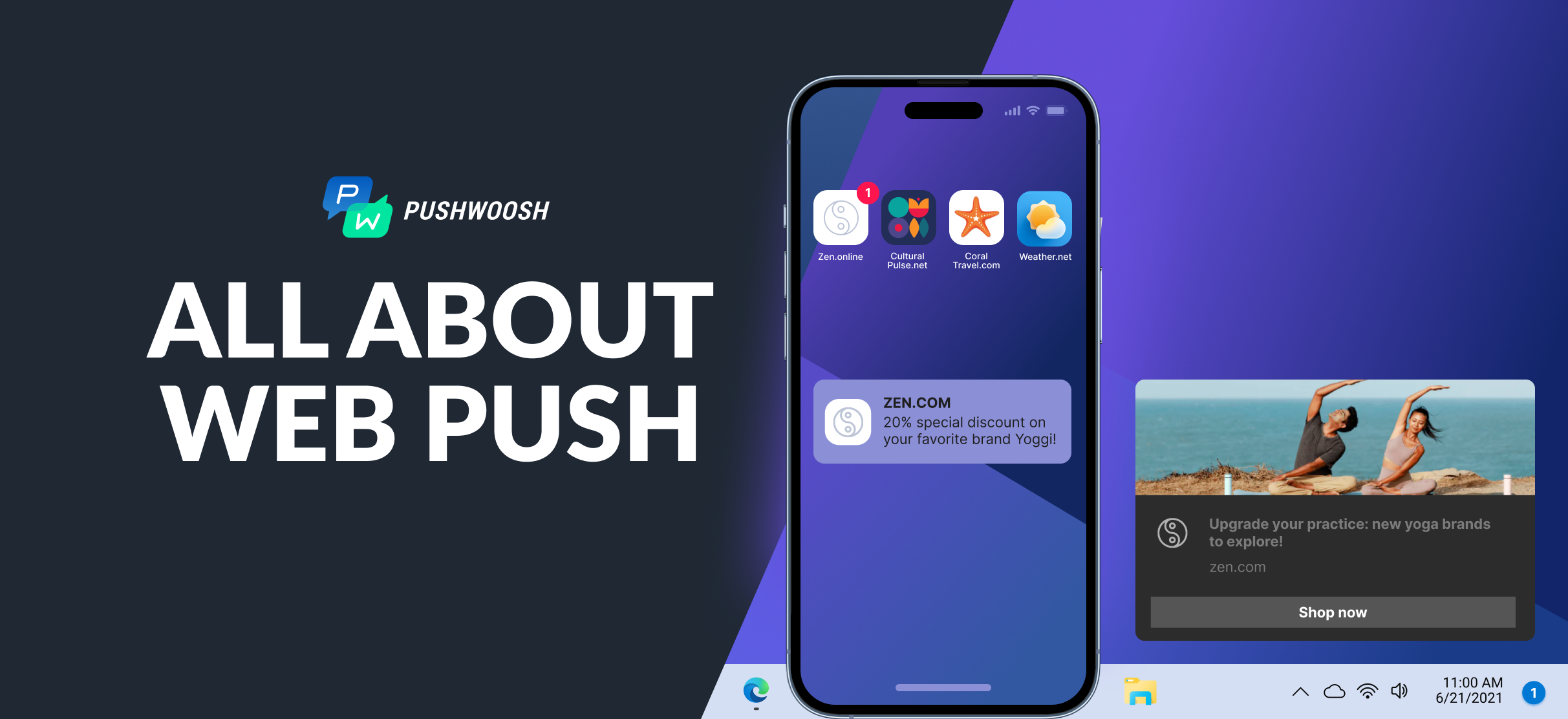Web push notifications are clickable push messages you receive in your desktop browser or mobile browser. These alert-style messages slide in at the top or bottom right corner of a desktop screen, depending on the browser, or appear on a mobile device screen, almost like mobile app push notifications do. Web push notifications are delivered anytime your users have their browsers open — regardless of whether they're on the website or not.
Web push notification FAQ
What are web push notifications vs push notifications?
Web push notifications, as opposed to traditional push notifications, are messages sent to users through web browsers rather than mobile apps.
What is a web push notifications example?
An example of a web push notification is a news website notifying users about breaking stories or a sports website notifying users about live event updates, such as score changes.
Can web push notifications be sent on iOS and iPadOS devices?
In February 2023, Apple unveiled an exciting update: Web Push support was integrated into iOS 16.4 Beta. With this development, web push notifications became accessible to a wider audience, including iOS and iPadOS users, making it an ideal way for marketers to reach high-value segments.
In summary, web push notifications are now compatible with all major desktop and mobile platforms, such as Android, iOS, macOS, Windows, and Linux. Additionally, they are fully supported by the leading web browsers, including Chrome, Safari, Firefox, Edge, Brave, and Opera.
What are the web push notifications benefits?
Timely delivered web push notifications are effective for boosting website traffic and increasing conversions to a target action. Messaging via this channel drives user engagement because web push notifications are personalized, highly contextual, and reach users in high-impact moments. Sliding on a user's screen while they're surfing the web, they are pretty hard to ignore and capture attention easily.
Besides, a major advantage of web push notifications is that they give you the ability to re-engage users without knowing their contact details. Web push notifications don’t need a user’s email or other contact details. If a user once visited your website and has given their permission to send them notifications, they can receive notifications anytime.
The elements of a web push notification
There are 6 key elements that create a web push notification - Title, Description, website URL, Icon, Banner Image, and Call To Action Buttons. You can also add emojis to web push notifications to increase CTR by over 100%.
- Title: The notification title is what your users read first, it should capture attention. That's why try to make it urgent, funny, or inquisitive – write content that shows some kind of urgency or creates curiosity. This will lead to an increase in click rates.
- Description: This is where you briefly mention what your message is about. The description should be in line with the title. For example, if you are using the Urgency type, then maintain it in the description as well.
- Website URL: The website domain that has sent the notification.
- Call to Action Buttons: These buttons can be used to trigger certain actions. You can use them to take the user to a landing page, where they can buy something, or trigger the App Store launch so that they can install your app.
- Icon: Add an icon to your notification - it's also your signature that makes a web push more noticeable and distinguishable. Nowadays users are getting bombarded with notifications, so it's extremely important to let your users know when your push notifications pop up.
- Banner Image: The text of your notification may already be engaging, but adding a banner image will increase your chance of getting that click.
Web push notifications campaigns: use cases
Web push notifications can be used to effectively engage users across industries:
E-commerce: Delivering timely sales alerts, coupons, and personalized offers to engage and incentivize customers.
Media: Notifying users about newly posted content, ensuring that audiences stay updated and engaged with fresh information.
Weather sites: Providing users with timely weather updates, alerts, and forecasts, ensuring that customers are well-prepared for changing weather conditions in their area.
Travel sites: Reminding users of their upcoming vacation bookings, offering packing tips and destination insights to enhance their travel experience.
Across all industries, businesses can collect user feedback and promote marketing surveys to gain valuable insights into customer preferences and needs while also automating loyalty programs to reward and engage users with relevant incentives and benefits.
How to set up web push notifications?
While setting up web push notifications on your own offers control and customization, it requires some coding skills and technical knowledge. If you're not comfortable with this, consider using web push notification service providers, which offer full-service platforms for easy integration.
Best browser push notification service
Pushwoosh's browser push notification service is your key to real-time user engagement, resulting in amplified website traffic, improved CTR, and higher conversion rates. Here is why Pushwoosh is a top choice among web push notification providers:
Pushwoosh excels in segmentation capabilities based on historical data. Pushwoosh’s advanced segment builder empowers marketers to create segments based on the combination of users’ attributes and past actions for highly targeted web push notification campaigns.
Pushwoosh offers the powerful Customer Journey Builder, streamlining web push campaigns. With Customer Journey Builder, you can automate opt-in, onboarding, engagement, and retention campaigns, as well as combine them with other messaging channels.
Additionally, the Pushwoosh team comprises experts who specialize in addressing unique use cases across various industries, including media, sports, e-commerce, travel, and weather websites. With our expertise, your web push notification campaigns will be finely tuned to your specific industry, maximizing CTR, conversion rates, and marketing ROI.
Сontact our team for a personal product tour:

